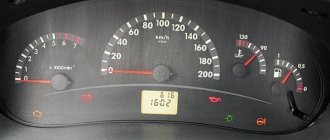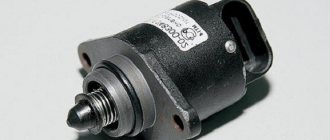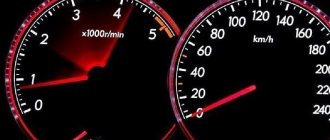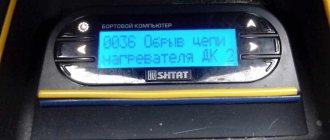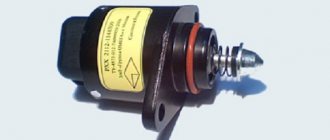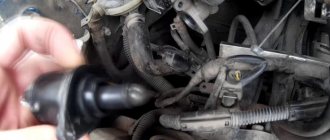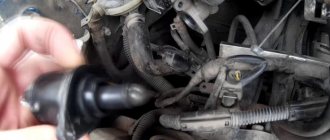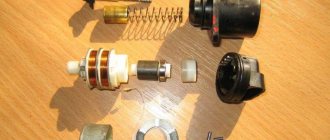The ability to implement feedback is an advantage of electronic fuel injection systems and their fundamental difference from other power systems of internal combustion engines. In this case, we are talking about controlling the mixture composition and directly regulating the engine operating mode itself - the injection ECU can either adjust the speed in a certain range (cars with a “mechanical” throttle) or control them (an “electronic” throttle).
However, situations are possible when the ECM is not able to support the desired mode. One of the characteristic symptoms of this is the “swimming” of revolutions, their constant change with clearly defined periodicity.
IAC cleaning
Do-it-yourself troubleshooting of the idle air regulator consists of simply washing it to remove carbon deposits. To do this you need to follow the instructions:
- disconnect the wire plug from the sensor;
- Unscrew the two fastening screws with a small shaped screwdriver and remove the sensor from the mounting socket;
- Clean the needle cone using WD-40 or carburetor cleaner.
The same means can be used to wipe the regulator contacts and the entire throttle assembly.
Throttle valve
When the driver presses the gas pedal, the throttle valve opens, allowing more air into the combustion chambers. Oxygen is mixed with fuel, after which the prepared mixture burns. The more the driver presses the gas pedal, the wider the throttle opens and the more air flows in. But often carbon deposits accumulate on the walls of the damper, and its loose closure causes disturbances in the operation of the power plant.
The throttle assembly is located behind the engine air filter. This arrangement is typical not only for the Lada Kalina, but also for many other cars. Depending on the engine type, the damper operation can be controlled by an electronic gas pedal or a cable drive.
Many car enthusiasts have come across the concept of floating engine idle speed. For the Lada Kalina, as practice shows, this is a common malfunction that can be fixed with your own hands, but sometimes you will need to use a car service.
RPM fluctuates at idle
This may be due to many factors.
Let's consider the main reasons for the occurrence of floating engine speeds:
- Fuel system malfunction
.Malfunction of fuel system elements
- Ignition problems
.Problems with the ignition switch or wiring
- ECU errors
.Troubleshooting ECU errors
- Poor quality fuel
.Low-quality gasoline directly affects the operation of the power unit
All these reasons contribute to the appearance of such an effect. The most common reason is problems with injection.
Treatment methods
So, let's consider the sequence of actions to eliminate the causes of floating engine speed.
Fuel system
As practice and experience show, floating speeds appear in the event of an uneven supply of fuel to the combustion chambers, or a constant change in the amount of the fuel mixture.
Cleaning a removed injector
First of all, this is due to the injectors, which may be dirty. At the same time, this may not be felt when driving, but at idle the tachometer will immediately show it. Therefore, it is necessary to dismantle and check the injectors on a special stand.
Clean fuel pump mesh
Also, the malfunction may be caused by a breakdown of the gasoline pump, which does not supply fuel evenly or a clogged fuel filter. If necessary, you need to replace the filter element and check the fuel pump.
Cleaning the throttle body
A change in the amount of fuel mixture may be due to a clogged throttle or worn air filter. Therefore, the filter element changes, and...
Removed throttle before and after cleaning
Ignition problems
Problems with idle speed may occur due to incorrect operation of the ignition system. Namely, it may be related to the lock or wiring. So, it is worth checking and, if necessary, replacing damaged elements. It is best to change the ignition switch assembly and test the wires that go from it to ensure they are working properly.
ECU errors
Often, a car malfunction is associated with, as well as a malfunction of the controllers on the board. Of course, another reason could be the firmware that is out of order. Many car enthusiasts change the operating system, but this does not always help.
ECU removed from the vehicle
As practice shows, an ECU malfunction can pose a problem for the performance of many systems. Therefore, if the fault cannot be eliminated using the previous methods, it is necessary to replace the control unit. Of course, installing the operating system from the Lada Kalina Sport K-Line can help, but the problem does not always disappear completely.
Poor quality fuel
In many cases, poor quality of the fill can cause clogging of the fuel pipeline and injection system, which in turn gives the effect of uneven fuel supply. To eliminate the malfunction, you should drain the old fuel, clean the fuel system and fill in with new high-quality gasoline.
It is worth understanding that not only the operation of the engine, but also its durability depends on the quality of the fuel.
conclusions
Floating idle speed of the Lada Kalina engine can cause other, more serious problems to appear. So, if such an effect occurs, it is necessary to find the cause and eliminate it. If you can’t do it yourself, you need to contact a car service, where they will quickly find and fix the problem. Repeatedly, due to the constant effect of floating speed, car owners have had to replace the electronic control unit.
Good day to all. Lately I've been getting a little annoyed that the car has become a little dull. Floating speed, unstable engine operation. I noticed that when starting the car when cold, the revolutions jump sharply to 2 tons, and slowly slide down to the required 1300-1500. Sometimes it happens that after 3 times you start the car, it stalls and that’s it! I decided to go first by replacing the air filter and cleaning the throttle body. Removing the damper.
To do the work, you will need a 5-inch hexagon, a Phillips screwdriver, or a 7-mm socket
1 Unscrew the corrugation going from the filter to the intake manifold 2 Using a hexagon, unscrew the 4 bolts securing the throttle valve. 3 Take carburetor cleaner and clean off carbon deposits and dirt.
As soon as I removed the throttle valve, I saw a small (well, sort of) carbon deposit, and oil residues (For some reason, the question immediately arose: What the hell am I doing?
. In general, after cleaning the throttle, I put everything back in the reverse order and changed the air filter. Although the old one lasted only 15 k (and the factory recommends changing it every 30,000) - Why? - Yes, just like that, it was already dirty and dust was falling out of it, and I decided “why not change it!”
RPM fluctuates when cold
When cold, the speed floats, with increased fuel supply to the cylinders for quick warm-up, when there is a leak of unaccounted air in the intake manifold, in case of problems with sensors (oxygen, throttle position, mass air flow, engine temperature sensor), low fuel pressure, faulty regulator idle speed and a number of others, depending on the type of engine. If the sensors are faulty, the ECU issues incorrect commands, which can cause the engine speed to fluctuate when cold.
Most of the problems, regardless of whether it is an injector, a carburetor or a diesel engine, are the same, but there are also some peculiarities that may be the reason why there are drops in speed when cold, and often when hot too. In short, all the reasons why the engine does not maintain speed when cold are displayed in the table, but if you need more specific recommendations for eliminating jumps in the speed of a cold engine, read the article and the comments to it, where car owners often share their experience.
| Cause of malfunction | Faulty node | Necessary actions |
| Injector | ||
| Atmospheric air suction |
| Check all the listed parts by pinching the hoses, using a compressor (compressed air), or a smoke generator |
| Engine sensor malfunction |
| Perform diagnostics of the listed sensors. If necessary, replace them with new ones. |
| Insufficient fuel to maintain engine speed | Perform diagnostics, cleaning or replacement of injectors. Fuel up with better quality gasoline. | |
| Problems with the ignition system |
| Check the operation of the listed elements. The spark plugs can be cleaned or replaced. Wires and coils are replaced with new ones. |
| Compression reduction |
| Perform a compression check in the cylinders, repair measures depending on the diagnosis |
| Low fuel pressure |
| You need to check the fuel pump, fuel filters (fine filters and mesh), and pressure regulator (the mesh may become clogged). |
| Carburetor | ||
| Not enough fuel or air | Incorrectly adjusted carburetor or clogged jets | Adjust the carburetor, select the optimal idle speed, and clean the jets. |
| Excess air intake | Dirty throttle valve | Clean the damper, check its drive |
| Aperture malfunction | Check and, if necessary, replace the unit | |
| Carburetor gasket | Replacing the node with a new one | |
| Solenoid valve | Diagnostics and, if necessary, valve replacement | |
| Diesel engines | ||
| Insufficient fuel pressure |
|
|
| Incorrect commands from the electronic control unit |
|
|
| Excessive exhaust gases in the intake manifold | EGR system | Check the EGR valve and the operation of the entire system. Correct it or properly suppress it. |
| Air in the fuel line |
| Check the listed elements, if there is a diesel leak, restore the seal, replace the fuel filter. |
The cause of a stalled engine is a power supply failure
In this type of problem, 3 reasons may be involved:
- Poor contact with the terminals of the new battery;
- Detection of poor contact or breakdown along the entire length of high-voltage wires;
- The appearance of malfunctions in the generator or ignition coil system of the car.
If the problem lies in damp high-voltage wires, then it is best to replace them completely along with the battery contacts. If the terminals make poor contact, you need to carefully clean them with sandpaper and try to reconnect them. If the generator is found to be inoperable, the problem usually boils down to problems in the following parts:
- Broken timing belt;
- There is a malfunction inside the housing of the unit itself.
Replacing the idle speed sensor on Kalina
The operation of installing or removing the product is not particularly difficult and is accessible to any car owner, regardless of the level of training, under almost any conditions. Replacement is carried out in the following sequence: 1. First step. During any work related to the vehicle's electrical system, the on-board system is de-energized (to do this, simply disconnect the battery terminal). 2. Second step. We find the regulator and disconnect the contact block with the supply wires from its body. 3. Third step. Using a long Phillips screwdriver, unscrew the mounting screws (2 pieces) and remove the product from the car’s throttle body. 4. We install the new product, the procedure is similar to the removal process only in reverse order. The new sensor does not require adjustment or configuration.
Measures to extend the service life of IACs
It should be noted that it is not always necessary to immediately replace the idle air regulator for an 8-valve Kalina with a new device. Quite often, its proper operation is prevented by banal contamination with oils and tar deposits contained in crankcase gases. Therefore, to restore the performance of the IAC and extend its service life, it is necessary to periodically clean the cone needle and the spring of the product from contamination. In addition, the installation hole itself in the throttle assembly must be cleaned. If you follow the above recommendations, the device will not fail at the most crucial moment and will last for a long time.
In the morning at -1, the revs on the tachometer are first 500, and after 1-2-3 seconds the warm-up speed is 1100. I changed the wires, changed the idle, changed the TPS, changed the spark plugs, changed the coil, called with a multimeter. I checked the DMRV readings 0.98. I installed a new air filter. I changed the idle sensor, removed the throttle, it was clean.
And still the relay makes one click and from 500 it is set to 1100, as it warms up everything is fine, then it is set to 900 and it starts without any hang-ups. I don’t know where to dig, what to look for?
The firmware has not changed, original Bosch. I don’t really know what the numbers are, just if you can write something. I’m already thinking, maybe there’s something wrong with the firmware during a cold start? So the main thing is that it warms up for 1 minute, I turn it off, start it again, this is no longer the case. It’s just some kind of trouble, and if the frost hits -30, it will completely shut down, well, in general, such things.
- At XX, the engine runs intermittently in the Lada Kalina - 7 answers
- VAZ Kalina stalls 2-4 seconds after starting – 6 answers
- It revs itself in the morning at idle, Kalina – 6 answers
- The idle speed on the VAZ Kalina jumped up - 6 answers
- VAZ Kalina stalls when cold or in the cold - 5 answers
If the engine is already running and produces 500 rpm. Then for some reason the relay clicks, right? There the IAC can only click, then yes, the speed will change if it is faulty. Do you have an IAC or a throttle assembly without it? As for changes in the weather and the dependence of engine operation - this could be due to a faulty mass air flow sensor or just because of the “wrong” air filter.
Which relay clicks? Which relay makes the click?
There in the engine only the IAC can click when starting. And these Russian regulators are of disgusting quality (I bought a new remote control, it was clogged and the heating did not work, and on the new IAC it jammed, replaced it, installed the old IAC and the motor worked fine).
You can read about the same story (about the wrong IAC) here.
You don’t have to bother with the firmware, you have a normal controller. And you can’t fix this question with firmware.
Source
So why is this happening
Root causes of problems
The most common situations in which floating speeds occur:
- Cars with a built-in electronic fuel injection system suffer from such problems much more often than others. And this happens due to the constant suction of excess air, the volume of which still increases, which leads to the formation of a malfunction. The sensor responsible for gasoline injection simultaneously calculates the volume of air entering the cylinders. Based on these and some other indicators of the sensors, the electronic unit opens the electromagnetic injection valves for some time. It follows from this that when there is an excessive amount of air in them, the sensor, which is responsible for the position of the throttle valve, shows the driver that the task assigned to the system is impossible - the check light is on. During this, the temperature sensor indicates that the engine is exiting the warm-up mode. This indicates that it needs less fuel. Just at such a moment, floating speed appears in the car at idle, because the electronic unit does not understand what to do with the accumulated excess air in the system.
- This reason also partially relates to air suction and occurs mainly on 16-valve engines. The main place where air leaks still occur is the gluing contour of the receiver elements. Even minor damage to this area will lead to unstable operation of the motor.
- Constant jamming also easily becomes a reason for the occurrence of floating speed. It occurs in the crankcase ventilation valve. Therefore, if the reason is precisely this phenomenon, the systematic operation of the automatic power regulation sensor is disrupted. As a result, the same sensor signals instability of the engine. In a faulty state, the speed ranges from 1,300 to 900 per minute.
- In models with a carburetor engine, floating speed occurs due to a violation of the control of the servomotor. To correct this problem, simply unscrew the adjustment bolts in the area of the servomotor where the sensor points to the loose drive.
- Low pressure in the fuel system causes the same problems.
- Breakdowns in the ignition system are sometimes also classified as causes of floating speed. The problem is primarily related to high-voltage wires and spark plugs. But only with a visual inspection will it be possible to understand whether they are really the problem.
- A breakdown of the IAC (idle air regulator) causes floating speeds, because it is responsible for their initial stability. The element is inexpensive and can be replaced, so there may not be any significant problems with this.
- The electronic gas pedal has a lot of disadvantages, especially if tuning the car is only in the process, but the car is actively used. Floating speed is a fairly common occurrence in such a situation.
The speed can fluctuate not only when the engine is cold, but also when the engine is hot. It all depends on the cause of this phenomenon.
So what to do if floating speeds appear with enviable frequency and significantly interfere with the quiet use of the vehicle?
Idle speed regulator Lada Kalina and its device
- a housing in which a stepper motor is located with two windings independent of each other, rotor supports (rear and front);
- valve shut-off needle and spring;
- power connector.
3 main functions of the controller
1. In addition to maintaining the required engine speed, the device ensures its proper operation under cold start conditions (warming up at sub-zero air temperatures). In this case, the regulator provides higher engine speeds until the latter warms up to operating temperature. 2. The second important function that many drivers don’t even think about is the speed maintenance mode without pressing the gas pedal. In other words, ensuring the engine operates at idle speed is the merit of the IAC. 3. The third and very important purpose of the product is to ensure the creation of an air-fuel mixture of the required concentration and saturation. This feature has a positive effect on final fuel consumption and smooth engine operation.
Functional features
The main purpose of the sensor discussed here in Lada Kalina is to measure the main parameters in the intake system and adjust the speed. This is done by sending pulses to the engine control module, which, based on the data received, adjusts the volume of injected fuel.
Due to the fact that the specified idle speed regulator acts as an actuator, determining its failure is a very difficult task. This is due to the lack of a useful self-diagnosis function in the Lada Kalina.
The device is designed to control the volumes of air that are directed through the intake tract into the combustion chambers of the engine. Here, the air mass (also measured by the mass air flow sensor) enters through a special channel, bypassing the throttle valve, which is closed in idle speed mode.
This idle speed regulator is involved in warming up the 8-valve engine, ensuring that the unit reaches its operating temperature in a timely manner.
When the ignition is turned on, a rod “crawls out” from the regulator and reaches a specially designed hole. This is called the initial position of the sensor.
Next, we outline the primary functions of this device:
- adjusting the optimal air mass;
- participation in warming up the engine 8 valves;
- determination and adjustment of the number of revolutions.
FakeHeader
Comments 21
When the rpm drops to 600 - is it once every about 30 seconds or constantly?
Once every 1-2 seconds
Then it's definitely not an adsorber. If the AIR fitting of the canister is clogged, then when the canister valve is opened, air will be driven out of the tank (the speed will drop exactly once every 30 seconds), but the canister works for no more than 3-4 seconds, after which it turns on again only after about 20-30 seconds. You can safely cross it off the list.
I’m having this problem myself now, but I have it once every 20-30 seconds, and that’s exactly when the adsorber valve opens for purge. I disconnected the hose from the adsorber going to the valve, the speed stopped falling. It seems to me that this is exactly the situation when the AIR on the adsorber is clogged with dirt or coal. The valve opens and, instead of fresh air, draws gasoline vapor directly from the tank, then the rpm drops to 500 and a sharp rise to 1200. The valve closes and everything is fine until the next opening. =(
And what should I do with it so that the revs don’t fluctuate?
When the rpm drops to 600 - is it once every about 30 seconds or constantly?
And so on constantly in neutral until you turn it off. The voltage in the onboard after a drop in rpm also drops to 13.6 and rises with the rpm
The revs are fluctuating - first of all, look for air leaks. Whistling occurs more often. Possible places: a rubber plug on the intake manifold, a stuck absorber valve, a vacuum booster, stiffened injector rings and intake manifold seals at the joints. Everything is checked by clamping the pipes or temporarily replacing them with plugs. That is, for example, you pull out the vacuum pipe from the manifold and stupidly plug it with your finger, etc.
I have the same problem, but only in winter you stop at a traffic light and the revs start to float, also e-gas, the check does not light up, I changed the spark plugs, it helped, the factory spark plugs lasted 3000 km, new ones for another 4000 km, then I installed NGK, so far it’s ok
The main reasons for the reduction in engine power
Crankshaft position sensor malfunction
There are situations when the DCPV untimely sends a control command to supply the air-fuel mixture. As a result, the power of the power unit drops before our eyes. The main cause of the failure is the shift of the toothed star relative to the pulley and the delamination of the damper. In such a situation, it is necessary to carefully inspect the damper and replace it.
Increasing (decreasing) the gap between the spark plug electrodes
During operation, due to strong temperature effects, the distance between the electrodes of the spark plug may decrease or increase. To exclude or confirm your suspicion, you need to check the size of the gaps using a round feeler gauge. If the distance is less or more than acceptable, you need to make an adjustment by bending the side of the electrode or replace the spark plug. As for the optimal spark gap distance, it can be different (depending on the type of spark plug) - 0.7-1.0 mm.
Replacing the air flow sensor
The replacement procedure is as follows:
- First you need to loosen the clamp that secures the air duct, for this you use a Phillips-head screwdriver. The pipe itself can be dismantled.
- Disconnect the power connector from the regulator; to do this, simply press the latch at the bottom and pull the plug itself to the side.
- Next, using 10mm wrenches, you need to unscrew the two bolts. It may be difficult at this stage, so you can use a ratchet to unscrew the bolts quickly.
- The regulator can then be moved to the side and removed.
- The installation procedure is carried out in reverse order.
Tips and tricks
Let's look at how you can eliminate some of the malfunctions that lead to floating and speed jumps, and do it yourself.
- As mentioned above, the leakage of excess air can cause surges. To exclude or confirm the possibility of supplying such air, you need to check the tightness of the air supply system to the intake. You can remove the air hose and feed it air from a compressor or pump by placing the hose in a container of water. This method helps to identify cracks.
- As for the idle air control, you need to measure the resistance with a multimeter. If the resistance is between 40 and 80 ohms, this means that the device is not working.
- Also, as part of diagnostic procedures, in some cases it is necessary to clean the crankcase ventilation valve. The valve must be removed and washed with carburetor cleaning fluid or kerosene. This approach will remove deposits from the valve.
- As for the ECM sensors, in this case it is not advisable to try to repair such elements. For example, if the mass air flow sensor is faulty, it is better to immediately replace it with a new one.
- It is better to trust specialists to flush the throttle valve without proper experience, especially if such flushing is necessary with the removal of the valve. If we talk about the method of flushing the throttle without removing it, you can do the procedure yourself. The hoses are disconnected from the valve, then a cleaning aerosol is injected into the throttle.
The main thing is to disconnect the electrical contacts from the throttle valve. Let us add that on many cars where the damper was heavily dirty, you then need to additionally set the correct opening gap of the damper or “teach” the throttle using the appropriate equipment.
- On a car with a carburetor, you need to adjust the idle speed by setting it with the quality and quantity screws on the carburetor. The idle jet may also need to be cleaned. To do this, it is often enough to inject a carburetor cleaning aerosol and then blow it with compressed air.
According to drivers, this helps protect the pump from corrosion and is a preventative measure. At the same time, we note that this method is suitable for construction equipment and it is highly not recommended to practice such solutions on modern diesel internal combustion engines.
Diagnostics
Have you noticed the above “symptoms”? Make sure that it is a faulty sensor that is causing the problem. If you have a voltmeter among the tools, you can carry out the diagnostics yourself.
Checking the circuit
Before checking the circuit, prepare a multimeter in advance and set it up to work. Next, open the hood and disconnect power from the idle air control. Then you need to set the voltmeter operating mode on the multimeter. The black probe needs to be connected to the ground of the car, and the red one is connected one by one to all the terminals on the block.
Checking the idle speed sensor on Lada Kalina
Using the help of a second person, start the engine and watch the multimeter readings. The parameters must be within 12 volts. If the multimeter shows a value that is significantly lower than expected, the cause must be sought in the battery, and when the voltage is completely absent, the cause must be sought in the wiring or in the engine control unit. If during verification it turns out that the circuit is working properly, you can focus on the sensor.
Sensor check
When checking the sensor, the multimeter must be switched to resistance testing mode. Next, regardless of polarity, you need to connect the probes to terminals A and B, then to C and D. The resistance at the working sensor should be within 53 Ohms.
After this, you need to connect the probe to all terminals one by one. The multimeter should show “infinity” in all connection options
Car exhaust system problem
The engine may also stall if the tubes responsible for removing gases are malfunctioning. At full speed, the car will quickly begin to “choke”, and pressing the gas pedal completely stops the engine. Malfunctions in the operation of the exhaust pipe system in 90% of cases are caused by contamination and clogging of the muffler. However, the catalyst may also fail.
In the first case, carefully clean the muffler and remove foreign objects from there. If there are problems with the catalyst, conduct a complete diagnosis of the exhaust system and replace this element.
